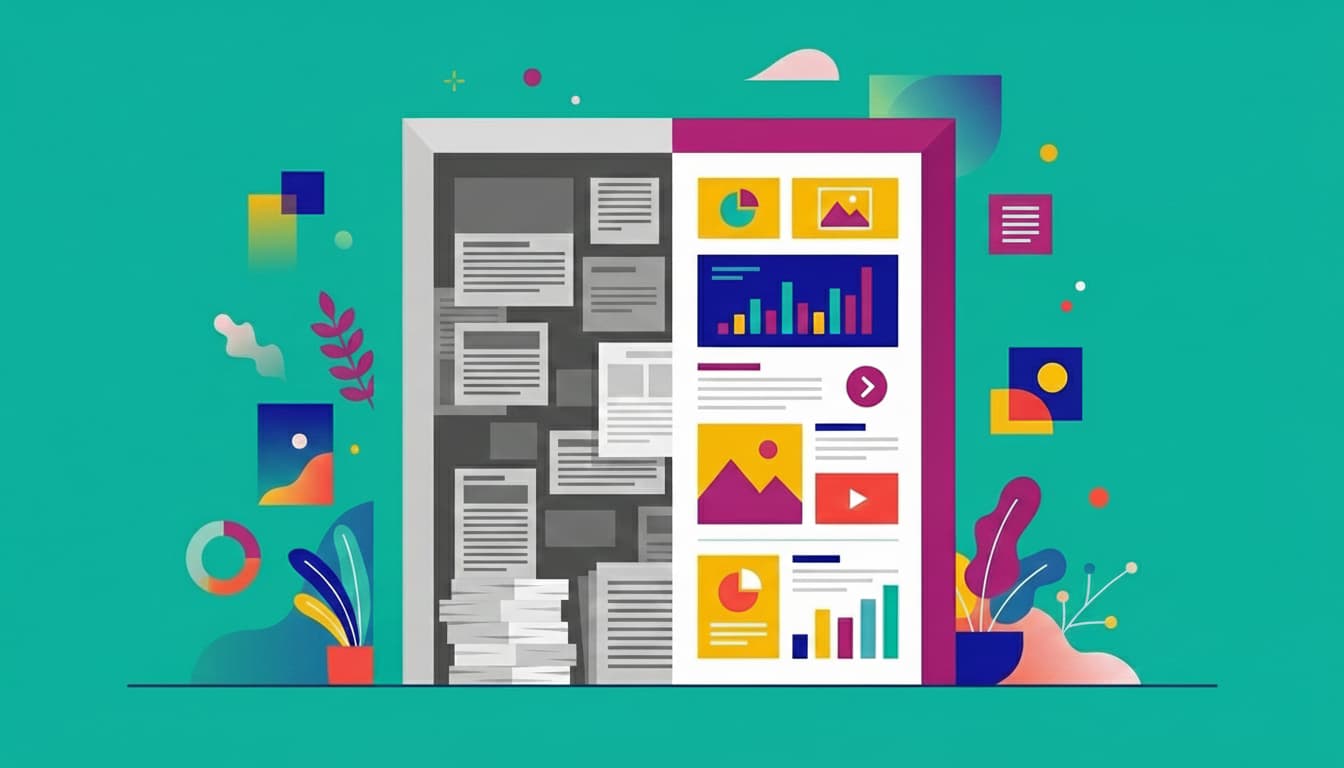Almost everyone is familiar with the PDF format as it has been around since the dawn of time. Ok, not literally - but it is older than you might think. The PDF was invented in 1993 and has gotten several updates throughout the years. The arrival of the interactive PDF in 1996 provided the reader with options to click links and fill out forms. Interactive PDF has long been the go-to format for sharing documents. But let’s be honest: the interactive PDF has become outdated and cumbersome with other, better ways to serve content in 2024.
Our digital landscape has changed drastically with the continuous development of artificial intelligence, social media and even reality-distorting media formats like AR and VR. It was only a matter of time before the PDF format would officially die out. Today is the day that we declare: the interactive PDF is done - and its replacement is digital publishing. Let us explain to you why.
The drawbacks of (interactive) PDFs
New options for document creation and sharing further emphasise the ineffectiveness of static documents. To showcase the strength of digital publishing as an upgrade of the interactive PDF, we must understand where the PDF format falls short.
Interactive - but not really…
We will dive head-first into the main problem with interactive PDFs. They claim to be interactive (it is in the name), but simply are not. They might have been considered interactive back in 1996 when being able to share a form in a document was considered revolutionary. But seeing how much we have progressed and how far web development has come, an “interactive” PDF is severely limited. Today’s readers are craving engaging experiences - especially as our attention span grows shorter every year. Capturing and retaining attention is hard, and you won’t succeed in doing so with an interactive PDF.
Not accessible means not inclusive
User experience is more important now than ever. By that, we don’t just mean the quality of content but also its accessibility. With designers and web developers paying attention to WCAG standards and practices daily, PDFs haven’t even made an attempt. Almost twenty years later, the PDF still turns out problematic in making content accessible. The “interactive” PDF is not interactive for those who cannot read or navigate it. Inclusivity should be a crucial part of any business that wants to take social responsibility. Therefore, depending on a format that excludes a part of the audience is simply inexcusable in today’s world.
Not mobile optimised
The smartphone has become an integral part of our daily lives and connectedness to the world. It is safe to say that the majority of internet users navigate the web on their phones, which seems to increase every year. For that reason, it is highly recommended that content creators prioritise responsive documents to ensure content is readable on every screen. A PDF format still often fails to adapt to different screen sizes and orientations. Ironically, when searching for ‘pdf responsive’ in engines like Google, you will find mostly research papers about responsiveness in - you guessed it - PDF format.
.png)
Say hello to the age of digital publishing
That PDF should become a thing of the past is obvious. However, we need an alternative for our communications. Thus enters the era of digital publishing. Sounds great but… what does that mean?
What is digital publishing?
The meaning of digital publishing is varied and depends on context. For some, it may mean ‘any content that is published digitally’. We like to refer to it as the translation of print formats into their digital counterpart. Back in the day, we used print for any means of communication. Those days are over with the birth of the internet and technological advancement. Such traditional print formats can be adapted and altered for the web. Think for example of online magazines, digital product brochures, interactive annual reports and e-books. Nowadays, digital publishing is interpreted much wider with the general publication of content that was not necessarily printed before, for example, blogs, social media posts and interactive presentations.
Why digital publishing is the new solution
Digital publishing has become an integral part of many companies’ marketing strategies. That is why there have been developed many different digital publishing platforms - some with a focus on website development like WordPress and others more specialised in designing digital publications like Maglr. These platforms offer a range of features to create content and enhance reading experience. Digital publishing simply offers options that an interactive PDF cannot match. We have listed just a few (out of many) of the advantages for you.
Engaging and involving audiences through interactivity
In the end, every business needs conversions and conversions are largely driven by audience engagement. So what drives engagement? Research proved several times that interactivity is the key to capturing and retaining attention. The type of interactive content that today’s audience craves should offer more than clickable links and filling out forms. Readers want to be involved in the experience rather than being a passive observer. For example, incorporating interactive elements like quizzes, polls, and clickable features lets the visitor become part of the story. Providing them with control over navigation and allowing them to change content based on their input provides a memorable experience that is likely to create a positive association with your brand.
Accessible and responsive on any device
We’ve established the importance of accessible content earlier in this article. This is where digital publications truly shine. Digital publications are often converted to valid web pages that can be navigated like a regular website. That means that they can be optimised for accessibility in the same way. Moreover, web designers often prefer to design mobile-first due to the increasing need for responsive websites. Digital publications too can be easily designed and published with responsiveness in mind. A combination of both ensures your content is readable by everyone at any time on any device.
Tracking reader behaviour
Back in the day, when we were still dependent on print, there was practically no way to know whether your content had been read. Insight into reading behaviour was simply invisible unless you could talk to the reader. But as marketers, it is incredibly valuable to know the interests of your target group. Digital publishing, being a form of publishing that integrates into the web, introduces options for tracking reader behaviour. With many types of analytics tools at our disposal, integrations are quick, simple and effective. Moreover, measuring results leads allows content creators to make strategic decisions through data.

Flexible and scalable
Ever had your file names look like this? It’s ok - we’re guilty of it too. Content creation is an ongoing process and edits are inevitable. Digital publishing provides us with the comfort of easily publishing content - sometimes even with the mere click of a button. It is much more flexible and scalable than any static file format. The speed with which content is produced, updated and published allows content creators a competitive advantage in today’s fast-paced digital landscape.
How to get started with digital publishing
Alight, let’s say you are convinced. Interactive PDFs have outlived their usefulness, and digital publishing is the new alternative. How would you go about making that switch?
The transition from interactive PDFs (or any other means of static communication) to digital publishing is simpeler than it may seem. The first step would be to assess your current content and identify which formats could benefit from a more dynamic and interactive approach. Once identified, it is time to orient on the diverse digital publishing platforms out there. Make sure to choose a software tool that best fits your company's content strategy. Got the plan and the platform? Take some time to train designers and marketers on how to use new tools and techniques for digital publishing. With a bit of time and effort, you will be able to make the transition effortlessly while paving the way for a more future-proof publishing model.
Inspiring examples of digital publications
Do you want to experience a few digital publications before deciding to venture into the digital publishing industry? We have compiled a list of inspiring examples for you. These publications showcase that digital publishing can be applied to any story and industry. From sleek, corporate designs for a sustainability report to playful, interactive layouts in ebooks - the possibilities are endless. Check out our examples page or refer to specific publication types below:
- LC Packaging - Sustainability Update 2023 (sustainability report)
- Van Oord - Marine Ingenuity (online magazine)
- Renault - Everything about electric driving (scrollytelling page)
- Alfen - Electric vehicle smart charging solutions (product brochure)
- dentsu at Cannes Lions (micro-site)
Let’s ban the interactive PDF together - for good
We’re serious - it’s time to say goodbye to interactive PDFs. Join us in the battle against static and boring content. Maglr is an excellent digital publishing platform that offers a range of features. With its easy-to-use drag-and-drop interface, anyone can create content effortlessly. Maglr also provides customisable templates that help you create your content faster. Moreover, the platform comes equipped with analytical tools that track engagement and performance, along with a native dashboard to view statistics. Get your 14-day trial today or request a live demonstration - we are eager to help!










